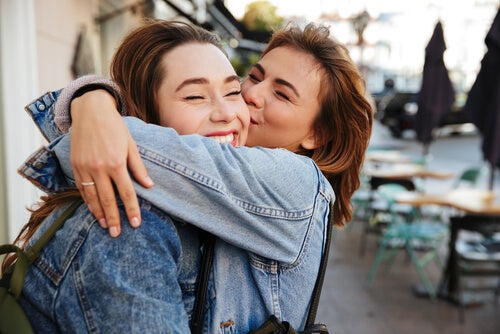The Way You Greet People Says a Lot about You

An interesting and representative aspect of social interactions is that there’s more than one way to greet people and that it depends on the cultural context.
But beyond a particular culture, family, or social group, your personality and the bond you establish with those around you are on display when you greet them.

Cultural greeting styles
Both the first greeting between two people that haven’t met before and that of two people who already have a strong relationship show a style of relational expression.
- In France, people who know each other and have some kind of relationship kiss three times on both cheeks.
- In Spain, however, men shake hands or hug, whereas between women, and between men and women, it’s more common to kiss on the cheeks twice.
- Both Italian men and women shake hands with other men and women. But if it’s been long since they’ve seen each other, they exchange a hug.
- In Chile, men shake hands among themselves, but between men and women, one kiss on the cheek is standard. Bolivia and Peru do this as well.
- However, in Argentina people greet each other with a kiss on the cheek, even from the first encounter.
- In Morocco, women cover up their entire bodies except for their eyes and ankles. They walk far behind men, and of course, there’s no display of affection whatsoever.
- Finally, in Eastern Asian countries, especially in China, men and women walk apart from each other: the man walks about three feet ahead, and people greet each other with a typical bow that requires no physical contact.
Greeting styles according to gender
It’s interesting how women have less inhibition when they greet each other, at least compared to men. In fact, women usually avoided contact with men, especially until the ’60s. But the fact that a series of female-male stereotypes lost credibility in the 60s, which disrupted Victorian sexual obsessions), made women take more initiative when it came to seductive games toward men.
For example, women not only have been historically greeting each other with a kiss: they’ve also started to hold hands on the street or grab each other by the arm. People associated such behavior with femininity, since it would have been strange for two men to do the same.
Furthermore, when it came to gender distinction, men were linked to rationality and emotional distance, whereas women were considered more sensitive and affectionate. However, in today’s society, revisionism is very prominent.
All these preconceptions create distinctions that keep people from showing affection physically. In other words, certain rules that context imposes, make the display of affection more or less malleable. Context either forbids or stimulates contact.
Family types
Parents, when forming their family, establish certain rules and behaviors that they deem acceptable and apply them from the very first moment that they interact with their children. That’s how relational and affective codes form and they might be different from family to family. Usually, these codes rely on social stereotypes.
- There are families whose emotional interaction patterns are very limited. They avoid kissing, hugging, caressing, or even making eye contact. Furthermore, they express their affection by providing material goods, such as clothes, trips, money, flowers, and other gifts.
- Other families show affection through their words. They don’t make gifts, but they often say how much they love each other, even if they never kiss, hug, or touch.
- Then, there are those who show their love through their actions. In this setting, family members do things for each other. They help one another, know exactly what the other person needs, and are always looking out for their well-being.
- Finally, some families simply don’t have any inhibitions when it comes to physical contact. They express their affection by constantly using their bodies to hug each other.

It’s clear that the healthiest display of affection in a family is the one that combines multiple ways of expression, and where the family members find the appropriate mechanism that fits them best.
However, there’s always one predominant style of expression that a new family adopts. People usually do either exactly the same or the opposite of the family pattern they grew up in; in general, there’s no in-between. This means that human beings tend to identify with certain stereotypes, to then appropriate and repeat them in other relationships outside of their family.
Types of greetings
If you pay attention, the way you greet people gives an idea of how you act in terms of emotions and affection: the degree of ease (or rigidity) with which your body moves tells a lot about your feelings toward those around you.
First-encounter greetings
Some people don’t hug but instead, greet someone by waving. If we’re talking about men, for example, they usually present themselves more formally, even more so if they greet with a social smile and the typical “Nice to meet you”.
Formal
In a more extreme case, there are people who greet with a firm handshake and a slight army-like movement of the arm. And of course, there are also those who greet men specifically with a handshake, but they greet women with a kiss on the cheek.
Handshakes
The strength of the handshake is a very interesting detail: medium strength means that the greeting isn’t really relevant. Men who are in a more formal setting, shake hands several times and even squeeze the other person’s fingers. These are greetings you easily remember due to the pain they cause. In fact, many express their affection with their strength or by making rough movements.
Then, there’s the firm handshake with eye contact, which expresses social and personal confidence. Sometimes, people greet people with a flabby and slippery hand. They’re usually shy, have trouble making social interactions and don’t dare to establish deep relationships, so they get to know people only superficially. And that kind of handshake reinforces this theory, especially if they don’t make much eye contact.
Therefore, it’s normal to find that their hands are sweaty because they’re nervous and they’re tense due to the rush of the first encounter.
Between a handshake and a hug
Finally, there are those who confidently shake the other person’s hand and even place their left hand on top of it. This greeting style is halfway between a handshake and a hug. They’re clearly more open when it comes to physical contact, although their personality might be controlling and invasive.

All these aspects that you can see during a first encounter show relational complementarities. It’s sort of a game, a dynamic, that you can interpret in order to estimate what kind of relationship you can establish with the other person.
Although there are no fixed patterns when it comes to social interactions, these generalizations can give you an idea of what a person’s personality is like.
An interesting and representative aspect of social interactions is that there’s more than one way to greet people and that it depends on the cultural context.
But beyond a particular culture, family, or social group, your personality and the bond you establish with those around you are on display when you greet them.

Cultural greeting styles
Both the first greeting between two people that haven’t met before and that of two people who already have a strong relationship show a style of relational expression.
- In France, people who know each other and have some kind of relationship kiss three times on both cheeks.
- In Spain, however, men shake hands or hug, whereas between women, and between men and women, it’s more common to kiss on the cheeks twice.
- Both Italian men and women shake hands with other men and women. But if it’s been long since they’ve seen each other, they exchange a hug.
- In Chile, men shake hands among themselves, but between men and women, one kiss on the cheek is standard. Bolivia and Peru do this as well.
- However, in Argentina people greet each other with a kiss on the cheek, even from the first encounter.
- In Morocco, women cover up their entire bodies except for their eyes and ankles. They walk far behind men, and of course, there’s no display of affection whatsoever.
- Finally, in Eastern Asian countries, especially in China, men and women walk apart from each other: the man walks about three feet ahead, and people greet each other with a typical bow that requires no physical contact.
Greeting styles according to gender
It’s interesting how women have less inhibition when they greet each other, at least compared to men. In fact, women usually avoided contact with men, especially until the ’60s. But the fact that a series of female-male stereotypes lost credibility in the 60s, which disrupted Victorian sexual obsessions), made women take more initiative when it came to seductive games toward men.
For example, women not only have been historically greeting each other with a kiss: they’ve also started to hold hands on the street or grab each other by the arm. People associated such behavior with femininity, since it would have been strange for two men to do the same.
Furthermore, when it came to gender distinction, men were linked to rationality and emotional distance, whereas women were considered more sensitive and affectionate. However, in today’s society, revisionism is very prominent.
All these preconceptions create distinctions that keep people from showing affection physically. In other words, certain rules that context imposes, make the display of affection more or less malleable. Context either forbids or stimulates contact.
Family types
Parents, when forming their family, establish certain rules and behaviors that they deem acceptable and apply them from the very first moment that they interact with their children. That’s how relational and affective codes form and they might be different from family to family. Usually, these codes rely on social stereotypes.
- There are families whose emotional interaction patterns are very limited. They avoid kissing, hugging, caressing, or even making eye contact. Furthermore, they express their affection by providing material goods, such as clothes, trips, money, flowers, and other gifts.
- Other families show affection through their words. They don’t make gifts, but they often say how much they love each other, even if they never kiss, hug, or touch.
- Then, there are those who show their love through their actions. In this setting, family members do things for each other. They help one another, know exactly what the other person needs, and are always looking out for their well-being.
- Finally, some families simply don’t have any inhibitions when it comes to physical contact. They express their affection by constantly using their bodies to hug each other.

It’s clear that the healthiest display of affection in a family is the one that combines multiple ways of expression, and where the family members find the appropriate mechanism that fits them best.
However, there’s always one predominant style of expression that a new family adopts. People usually do either exactly the same or the opposite of the family pattern they grew up in; in general, there’s no in-between. This means that human beings tend to identify with certain stereotypes, to then appropriate and repeat them in other relationships outside of their family.
Types of greetings
If you pay attention, the way you greet people gives an idea of how you act in terms of emotions and affection: the degree of ease (or rigidity) with which your body moves tells a lot about your feelings toward those around you.
First-encounter greetings
Some people don’t hug but instead, greet someone by waving. If we’re talking about men, for example, they usually present themselves more formally, even more so if they greet with a social smile and the typical “Nice to meet you”.
Formal
In a more extreme case, there are people who greet with a firm handshake and a slight army-like movement of the arm. And of course, there are also those who greet men specifically with a handshake, but they greet women with a kiss on the cheek.
Handshakes
The strength of the handshake is a very interesting detail: medium strength means that the greeting isn’t really relevant. Men who are in a more formal setting, shake hands several times and even squeeze the other person’s fingers. These are greetings you easily remember due to the pain they cause. In fact, many express their affection with their strength or by making rough movements.
Then, there’s the firm handshake with eye contact, which expresses social and personal confidence. Sometimes, people greet people with a flabby and slippery hand. They’re usually shy, have trouble making social interactions and don’t dare to establish deep relationships, so they get to know people only superficially. And that kind of handshake reinforces this theory, especially if they don’t make much eye contact.
Therefore, it’s normal to find that their hands are sweaty because they’re nervous and they’re tense due to the rush of the first encounter.
Between a handshake and a hug
Finally, there are those who confidently shake the other person’s hand and even place their left hand on top of it. This greeting style is halfway between a handshake and a hug. They’re clearly more open when it comes to physical contact, although their personality might be controlling and invasive.

All these aspects that you can see during a first encounter show relational complementarities. It’s sort of a game, a dynamic, that you can interpret in order to estimate what kind of relationship you can establish with the other person.
Although there are no fixed patterns when it comes to social interactions, these generalizations can give you an idea of what a person’s personality is like.
This text is provided for informational purposes only and does not replace consultation with a professional. If in doubt, consult your specialist.







